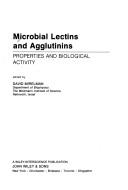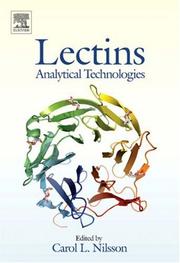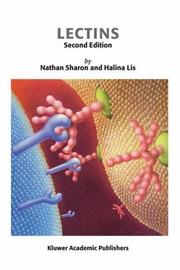| Listing 1 - 10 of 17 | << page >> |
Sort by
|

ISBN: 0471878588 Year: 1986 Publisher: New York (N.Y.) : Wiley,
Abstract | Keywords | Export | Availability | Bookmark
 Loading...
Loading...Choose an application
- Reference Manager
- EndNote
- RefWorks (Direct export to RefWorks)
Agglutinins. --- Hemagglutinin. --- Lectins. --- Microbial proteins.
Book
ISBN: 9789811904325 Year: 2022 Publisher: Singapore Springer Nature Singapore :Imprint: Springer
Abstract | Keywords | Export | Availability | Bookmark
 Loading...
Loading...Choose an application
- Reference Manager
- EndNote
- RefWorks (Direct export to RefWorks)
Fishes --- Lectins. --- Genetics. --- Protectins --- Receptor-specific proteins --- Hemagglutinin --- Immunoglobulins --- Fish genetics
Book
ISBN: 9811904316 9811904324 Year: 2022 Publisher: Gateway East, Singapore : Springer,
Abstract | Keywords | Export | Availability | Bookmark
 Loading...
Loading...Choose an application
- Reference Manager
- EndNote
- RefWorks (Direct export to RefWorks)
Fishes --- Lectins. --- Genetics. --- Protectins --- Receptor-specific proteins --- Hemagglutinin --- Immunoglobulins --- Fish genetics --- Lectines
Book
ISBN: 0444004009 Year: 1980 Publisher: Amsterdam Elsevier
Abstract | Keywords | Export | Availability | Bookmark
 Loading...
Loading...Choose an application
- Reference Manager
- EndNote
- RefWorks (Direct export to RefWorks)
Hemagglutinin --- Influenza viruses --- Genetic Variation --- Orthomyxoviridae --- Analysis --- Congresses --- Variation --- genetics --- ultrastructure

ISBN: 1281119938 9786611119935 0080548660 0444530770 9780444530776 9780080548661 9781281119933 Year: 2007 Publisher: Amsterdam ; Boston : Elsevier,
Abstract | Keywords | Export | Availability | Bookmark
 Loading...
Loading...Choose an application
- Reference Manager
- EndNote
- RefWorks (Direct export to RefWorks)
Lectins: Analytical Technologies covers both analytical and biological aspects of lectins (functional carbohydrate (complex sugar) recognition proteins) and provides researchers in the field with a resource containing background information and 'look-up' tables detailing lectin specificity and structures. Also included are methods and practical tips for designing new lectins from existing non-lectin proteins, automated approaches to lectin proteomics and high resolution mass spectrometry techniques. This book will be of interest to both novice and advanced researchers in biom
Lectins. --- Immunoglobulins. --- Antibodies --- Immune globulins --- Immune serum globulin --- Blood proteins --- Globulins --- Plasma cells --- Antibody diversity --- Antigens --- Bacterial immunoglobulin-binding proteins --- Protectins --- Receptor-specific proteins --- Hemagglutinin --- Immunoglobulins
Book
ISBN: 0124499457 0323144446 1299365418 Year: 1986 Publisher: Orlando (Fla.) : Academic press,
Abstract | Keywords | Export | Availability | Bookmark
 Loading...
Loading...Choose an application
- Reference Manager
- EndNote
- RefWorks (Direct export to RefWorks)
Lectins. --- 57.083.33 --- Lectins --- Plant lectins --- #WPLT:bioc --- Phytolectins --- Plant proteins --- Protectins --- Receptor-specific proteins --- Hemagglutinin --- Immunoglobulins --- Isolectin --- Animal Lectins --- Isolectins --- Lectins, Animal --- Serological reactions --- Plant lectins. --- 57.083.33 Serological reactions --- Animal Lectin --- Lectin --- Lectin, Animal

ISBN: 1402011725 9781402069536 1402066058 9781402066054 1402069537 Year: 2007 Publisher: Dordrecht : Springer,
Abstract | Keywords | Export | Availability | Bookmark
 Loading...
Loading...Choose an application
- Reference Manager
- EndNote
- RefWorks (Direct export to RefWorks)
This is the second edition of our little red book Lectins published in 1989. In the intervening years well over 10,000 articles have appeared with lectins as the main subject, and more than twice as many in which they were touched upon, as well as around 20 books. In particular, great strides have been made in several areas of lectin research, about which little was known until the late 1980s. One prominent example is animal lectins, many of which have been discovered only during the last decade and the functions of several of which have been clarified, especially as to their key role in innate immunity. Another is the structure of lectins and of their combining sites. Thus, whereas at that time the three-dimensional structures of just three lectins and a few of their complexes with sugars had been elucidated, their numbers have increased to about 160 and over 200, respectively, and continue to grow unabated. Updating the information on these and other topics resulted in a marked expansion of the book, which is now nearly four times as long as the first edition, with 226 figures and 39 tables. Still, a few topics, such as carbohydrate-binding cytokines or bacterial toxins that are sometimes considered as lectins, have been dealt with only in passing. Similarly to the first edition, Lectins II starts with an overview of the history of lectin research.
Lectins. --- Biochemistry, general. --- Lectins --- Protectins --- Receptor-specific proteins --- Life sciences. --- Medical microbiology. --- Biochemistry. --- Life Sciences. --- Medical Microbiology. --- Hemagglutinin --- Immunoglobulins --- Microbiology. --- Microbial biology --- Biology --- Microorganisms --- Biological chemistry --- Chemical composition of organisms --- Organisms --- Physiological chemistry --- Chemistry --- Medical sciences --- Composition
Book
ISBN: 9811515808 9811515794 Year: 2020 Publisher: Singapore : Springer Singapore : Imprint: Springer,
Abstract | Keywords | Export | Availability | Bookmark
 Loading...
Loading...Choose an application
- Reference Manager
- EndNote
- RefWorks (Direct export to RefWorks)
This book systemically presents the latest research on lectins, covering all the major topics in the field, including the heterocomplex of lectins and Toll-like receptors, protective versus pathogenic functions in connection with microbial infections, and novel strategies for enhancing host immunity against infectious diseases caused by viruses, bacteria, and fungi. Lectins are a large group of glycan-binding proteins that recognize diverse glycan and non-glycan structures expressed on prokaryotic and eukaryotic cells, and are vital to cell-cell interactions, the attachment of microbes to host cells, and the recognition and activation of immune responses to exogenous and endogenous danger signals. The composition and structure of microbes are complex and include numerous ‘pathogen-associated molecular patterns’ or ‘damage-associated molecular patterns’. As such, microbes’ interactions with immune cells activate multiple innate immunity receptors and produce distinct inflammatory reactions, which can be protective to contain microbial invasion, or pathogenic to cause tissue damage and shock syndrome in the host. The book shares lessons learned from state-of-the art research in this field, highlights the latest discoveries, and provides insightful discussions on lectin-mediated inflammatory reactions, while also outlining future research directions. .
Immunology. --- Medical microbiology. --- Biochemistry. --- Medical Microbiology. --- Biochemistry, general. --- Biological chemistry --- Chemical composition of organisms --- Organisms --- Physiological chemistry --- Biology --- Chemistry --- Medical sciences --- Immunobiology --- Life sciences --- Serology --- Composition --- Lectins --- Therapeutic use. --- Protectins --- Receptor-specific proteins --- Hemagglutinin --- Immunoglobulins
Book
ISBN: 3039288180 3039288172 Year: 2020 Publisher: MDPI - Multidisciplinary Digital Publishing Institute
Abstract | Keywords | Export | Availability | Bookmark
 Loading...
Loading...Choose an application
- Reference Manager
- EndNote
- RefWorks (Direct export to RefWorks)
The influenza virus poses a threat to human health and is responsible for global epidemics every year. In addition to seasonal infections, influenza can cause occasional pandemics of great consequence when novel viruses are introduced into humans. Despite the implementation of comprehensive vaccination programs, influenza viruses continue to pose an important and unpredictable global public health threat. They are one of the most significant causes of morbidity and mortality each year and have a significant economic impact. In recent years, research has been conducted to find alternative approaches to influenza vaccine development, including the generation of universal vaccines. Notably, significant progress in the field of influenza infection, transmission, and immunity have contributed to our understanding of influenza biology, and to expanding the technological approaches for the generation of more efficient strategies against influenza infections. Moreover, highly remarkable developments have been made in the implementation of new methodologies to evaluate the efficiency of vaccines and improve them for use on domestic animals such as poultry, horses, dogs or pigs. This enables us to decrease the exposure of humans to potentially pandemic viruses. The articles in this Special Issue will address the importance of influenza to human health and the advances in influenza research that have led to the development of better therapeutics and vaccination strategies.
heterosubtypic immunity of influenza --- master donor virus --- imprinting --- hemagglutinin --- universal vaccines --- pandemic --- adaptive immunity --- pregnant women --- innate immunity --- antibodies --- Influenza vaccine --- ARDS --- influenza A virus --- humoral response --- influenza vaccine --- original antigenic sin “OAS” --- germinal centers --- immunogenicity --- lung --- epitopes --- Influenza virus --- single nucleotide polymorphisms (SNPs) --- influenza virus --- protein microarray assay --- “universal” influenza vaccine --- vaccination --- influenza --- multiple dimensional assay (MDA) --- infection --- tissue resident --- memory --- vaccines --- CD4 T cell --- broad neutralizing antibody(bnAb) --- hemagglutinin (HA) of influenza virus --- original antigenic sin --- immune response --- morbidity --- T cell --- mPLEX-Flu assay --- Influenza A virus (IAV) --- virus–host interaction --- hemagglutin stalk --- memory B cells --- vaccine safety --- protection efficacy --- live attenuated influenza vaccine --- pediatrics --- vaccination rate
Book
ISBN: 4431560130 4431560157 Year: 2016 Publisher: Tokyo : Springer Japan : Imprint: Springer,
Abstract | Keywords | Export | Availability | Bookmark
 Loading...
Loading...Choose an application
- Reference Manager
- EndNote
- RefWorks (Direct export to RefWorks)
The book presents the latest findings on C-type lectin receptors, focusing on individual receptors and their signaling. In recent years there have been great advances in the understanding of the function of these receptors as a newly emerging family of pattern-recognition receptors (PRRs) for pathogen-associated molecular patterns (PAMPs) and damage-associated molecular patterns (DAMPs). Comprising four parts: ITAM-coupled Activating Receptors; HemITAM-bearing Receptors; ITIM-bearing Receptors; and Other Receptors and Related Topics, this comprehensive review covers a broad range of C-type lectin receptors. The updated information on C-type lectin receptors and their ligands provided will appeal to a wide readership, from basic immunologists to physicians and surgeons. In addition, sections on novel drug development make this a valuable resource for pharmaceutical scientists.
Pharmaceutical technology. --- Microbiology & Immunology --- Biology --- Health & Biological Sciences --- Lectins. --- Cellular immunity. --- Cell-mediated immunity --- Cellular immunology --- Protectins --- Receptor-specific proteins --- Clonal selection theory --- Immune response --- Immunity --- Hemagglutinin --- Immunoglobulins --- Immunology. --- Biochemistry. --- Biochemistry, general. --- Pharmaceutical Sciences/Technology. --- Pharmaceutical laboratory techniques --- Pharmaceutical laboratory technology --- Technology, Pharmaceutical --- Technology --- Biological chemistry --- Chemical composition of organisms --- Organisms --- Physiological chemistry --- Chemistry --- Medical sciences --- Immunobiology --- Life sciences --- Serology --- Composition
| Listing 1 - 10 of 17 | << page >> |
Sort by
|

 Search
Search Feedback
Feedback About UniCat
About UniCat  Help
Help News
News